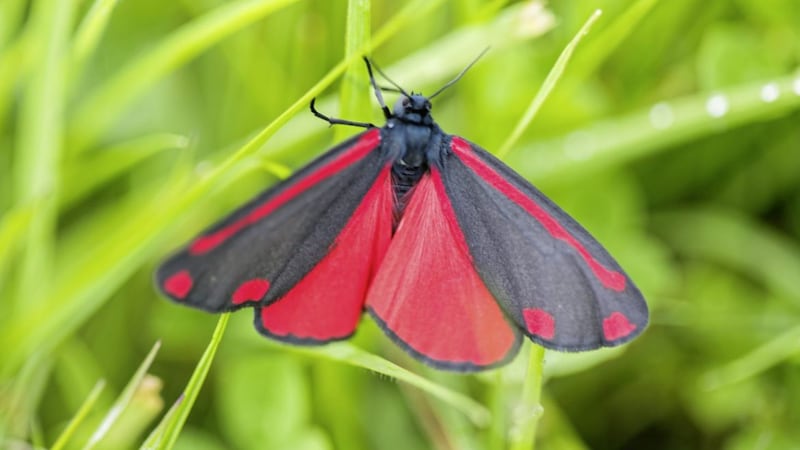IS THERE a protocol for dealing with a moth in distress? It could have been just having a bit of downtime and was not a bit bothered. And even if it was in trouble was there really anything a passing human could do?
The issue arose while out walking along a coastal path last week when I saw a cinnabar moth lying on the ground and flapping around without seeming to get anywhere.
These are one of our most strikingly coloured species, blood red stripes and spots on the blackest of black wings, flitting through the air or resting on yellow-flowered ragwort.
The caterpillars are not quite as dramatic but are also easily spotted clustering in small groups on ragwort – their bodies like that of an elongated wasp with dark yellow and black hoops.
My walk along the coast was on one of those days when a sharp, intense downpour of rain was followed by a sudden rise in temperature and a thick humid warmth. The cinnabar on the path may have taken a soaking and was just drying out before taking to the air again, but I eased it into my palm anyway and set it on a nearby cluster of birdfoot trefoil.
This is a plant that seems to thrive along grassy coastlines, clenched yellow flower petals on a green stalk, but if you run your fingers in among them you will find a group of pods that resemble the toes of a bird’s foot which gives this species its name.
The moth seemed unimpressed with where I had set it and still seemed to be struggling, its wings barely rising in pathetic out-of-sync flaps. Thinking it was best to leave it to its fate, I moved on but a few minutes later saw a cluster of ragwort. This looks like the sort of weed that breaks out on abandoned building sites or demolished buildings but is a common wildflower.
Turning back, I retrieved the moth from where it was still hanging half-heartedly on the trefoil and brought it to the ragwort, a plant on which it would have hatched, fed as larvae and then as a caterpillar before metamorphosising into its adult winged form.
Once in among the ragwort petals the cinnabar did suddenly seem to revive, its wings flapping with a bit more vigour and conviction although it had still not taken flight when I left it.
I have no way of knowing its fate – hopefully it revived and took to the air again or maybe it was too weak to recover. What it did bring home to me was how small micro-systems work. How the cinnabar larvae hatches and feeds on ragwort and grow into caterpillars before pupating over the winter and emerging in its striking adult moth form, presumably aiding the ragwort on which it feeds with its own propagation.
Ragwort is poisonous to mammals and birds, but nourishing to the cinnabar and, in an ingenious piece of evolutionary self-preservation, the caterpillars and the moths retain the poisonous substance in their bodies, making them unpalatable to predators.
Perhaps that is why it developed such striking colours – the distinctive red and black markings on its wings a stark message to anything that might consider eating it – back off, I am toxic and will make your life a misery if you eat me.
It is to these small observations rather than the bigger picture scenarios that perhaps we should give more attention to reawaken our understanding of the interconnectedness of nature and how the fate of one species can impact on another – our own included.








